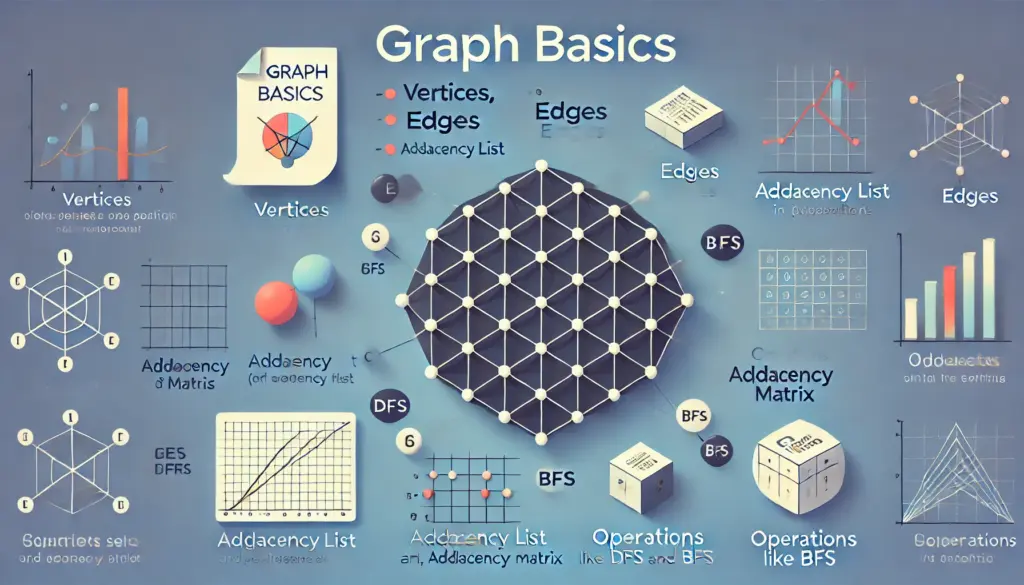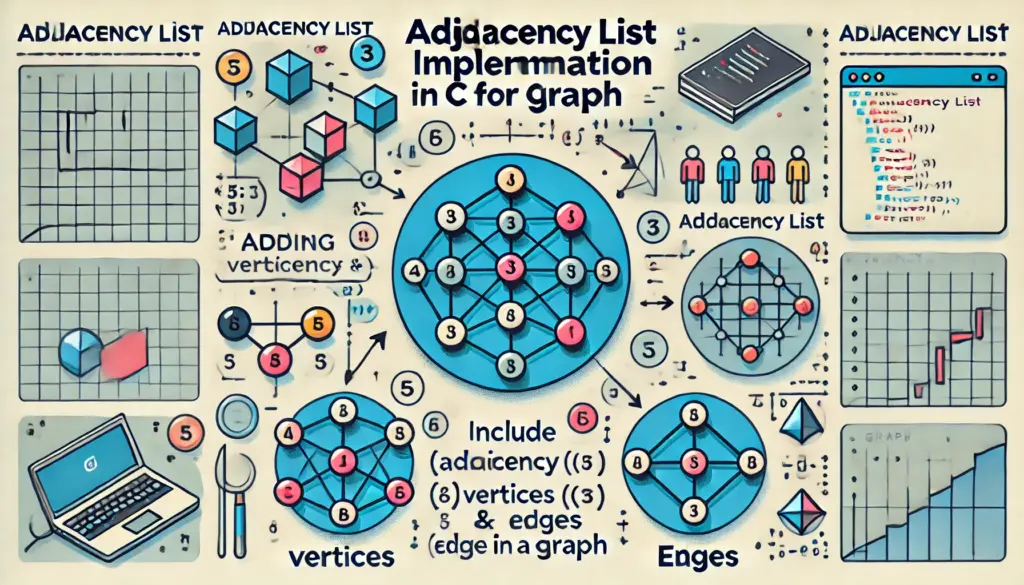【C言語】第8章第7回:グラフ構造と基本操作
Warning: preg_match(): Compilation failed: regular expression is too large at offset 46000 in /home/wp769435/a-mun.com/public_html/wp-content/plugins/easy-table-of-contents/easy-table-of-contents.php on line 1806

グラフ構造は、ノード(頂点)とそれらを接続するエッジ(辺)で構成される柔軟なデータ構造です。本記事では、グラフ構造の基本とその操作について学びます。
0. 記事の概要
この記事を読むメリット
- ネットワーク構造の理解:グラフ構造は、インターネットや交通網などを表現するのに適しています。
- 応用力の向上:経路探索アルゴリズムやソーシャルネットワーク解析の基礎を学べます。
- プログラミングの幅を拡大:基本的なグラフ操作を理解することで、複雑なデータを扱うスキルが向上します。
この記事で学べること
- グラフ構造の概念と種類
- 基本操作(頂点の追加、エッジの追加、探索)
- 実装例とその応用
活用のイメージ
- ネットワーク構造の理解:グラフ構造は、インターネットや交通網などを表現するのに適しています。
- 応用力の向上:経路探索アルゴリズムやソーシャルネットワーク解析の基礎を学べます。
- プログラミングの幅を拡大:基本的なグラフ操作を理解することで、複雑なデータを扱うスキルが向上します。
この記事で学べること
- グラフ構造の概念と種類
- 基本操作(頂点の追加、エッジの追加、探索)
- 実装例とその応用
活用のイメージ
グラフ構造は、地図の最短経路検索、ネットワークのトポロジー解析、ソーシャルネットワークの推薦アルゴリズムなどに応用されます。
1. グラフ構造の基本

1.1 グラフ構造とは?

グラフ構造は、頂点(vertex)とエッジ(edge)で構成されるデータ構造です。エッジによって頂点が接続され、ネットワークを形成します。
1.2 グラフの種類
- 無向グラフ:エッジが方向を持たないグラフ
- 有向グラフ:エッジが方向を持つグラフ
- 重み付きグラフ:エッジに重みが割り当てられたグラフ
1.3 表現方法
- 隣接行列:行列を用いて頂点間の接続を表現
- 隣接リスト:各頂点の隣接する頂点のリストを保持
2. グラフの実装
2.1 隣接リストによる実装
#include <stdio.h>
#include <stdlib.h>
// ノードの定義
typedef struct Node {
int vertex;
struct Node* next;
} Node;
// グラフの定義
typedef struct Graph {
int numVertices;
Node** adjLists;
} Graph;
// ノードを作成
Node* createNode(int v) {
Node* newNode = malloc(sizeof(Node));
newNode->vertex = v;
newNode->next = NULL;
return newNode;
}
// グラフを作成
Graph* createGraph(int vertices) {
Graph* graph = malloc(sizeof(Graph));
graph->numVertices = vertices;
graph->adjLists = malloc(vertices * sizeof(Node*));
for (int i = 0; i < vertices; i++) {
graph->adjLists[i] = NULL;
}
return graph;
}
// エッジを追加
void addEdge(Graph* graph, int src, int dest) {
Node* newNode = createNode(dest);
newNode->next = graph->adjLists[src];
graph->adjLists[src] = newNode;
// 無向グラフの場合
newNode = createNode(src);
newNode->next = graph->adjLists[dest];
graph->adjLists[dest] = newNode;
}
// グラフを表示
void printGraph(Graph* graph) {
for (int i = 0; i < graph->numVertices; i++) {
Node* temp = graph->adjLists[i];
printf("Vertex %d: ", i);
while (temp) {
printf("%d -> ", temp->vertex);
temp = temp->next;
}
printf("NULL\n");
}
}
int main() {
Graph* graph = createGraph(5);
addEdge(graph, 0, 1);
addEdge(graph, 0, 4);
addEdge(graph, 1, 2);
addEdge(graph, 1, 3);
addEdge(graph, 1, 4);
addEdge(graph, 2, 3);
addEdge(graph, 3, 4);
printGraph(graph);
return 0;
}
動作解説
- グラフの作成:
createGraph()で指定された頂点数のグラフを作成します。
- エッジの追加:
addEdge()で頂点間の接続を追加します。
- グラフの表示:
printGraph()で隣接リスト形式でグラフを表示します。
3. 探索アルゴリズムの実装
3.1 深さ優先探索(DFS)の実装

void DFS(Graph* graph, int vertex, int* visited) {
visited[vertex] = 1;
printf("%d ", vertex);
Node* temp = graph->adjLists[vertex];
while (temp) {
int adjVertex = temp->vertex;
if (!visited[adjVertex]) {
DFS(graph, adjVertex, visited);
}
temp = temp->next;
}
}
int main() {
Graph* graph = createGraph(5);
int visited[5] = {0};
addEdge(graph, 0, 1);
addEdge(graph, 0, 4);
addEdge(graph, 1, 2);
addEdge(graph, 1, 3);
addEdge(graph, 1, 4);
addEdge(graph, 2, 3);
addEdge(graph, 3, 4);
printf("Depth First Search starting from vertex 0: ");
DFS(graph, 0, visited);
return 0;
}
動作解説
- 初期化:訪問状況を記録する配列を用意します。
- 再帰的な探索:訪問していない隣接頂点を再帰的に探索します。
- 結果の出力:訪問した頂点を順番に表示します。
4. 練習問題
- 隣接行列:行列を用いて頂点間の接続を表現
- 隣接リスト:各頂点の隣接する頂点のリストを保持
2. グラフの実装
2.1 隣接リストによる実装
#include <stdio.h>
#include <stdlib.h>
// ノードの定義
typedef struct Node {
int vertex;
struct Node* next;
} Node;
// グラフの定義
typedef struct Graph {
int numVertices;
Node** adjLists;
} Graph;
// ノードを作成
Node* createNode(int v) {
Node* newNode = malloc(sizeof(Node));
newNode->vertex = v;
newNode->next = NULL;
return newNode;
}
// グラフを作成
Graph* createGraph(int vertices) {
Graph* graph = malloc(sizeof(Graph));
graph->numVertices = vertices;
graph->adjLists = malloc(vertices * sizeof(Node*));
for (int i = 0; i < vertices; i++) {
graph->adjLists[i] = NULL;
}
return graph;
}
// エッジを追加
void addEdge(Graph* graph, int src, int dest) {
Node* newNode = createNode(dest);
newNode->next = graph->adjLists[src];
graph->adjLists[src] = newNode;
// 無向グラフの場合
newNode = createNode(src);
newNode->next = graph->adjLists[dest];
graph->adjLists[dest] = newNode;
}
// グラフを表示
void printGraph(Graph* graph) {
for (int i = 0; i < graph->numVertices; i++) {
Node* temp = graph->adjLists[i];
printf("Vertex %d: ", i);
while (temp) {
printf("%d -> ", temp->vertex);
temp = temp->next;
}
printf("NULL\n");
}
}
int main() {
Graph* graph = createGraph(5);
addEdge(graph, 0, 1);
addEdge(graph, 0, 4);
addEdge(graph, 1, 2);
addEdge(graph, 1, 3);
addEdge(graph, 1, 4);
addEdge(graph, 2, 3);
addEdge(graph, 3, 4);
printGraph(graph);
return 0;
}
動作解説
- グラフの作成:
createGraph()で指定された頂点数のグラフを作成します。
- エッジの追加:
addEdge()で頂点間の接続を追加します。
- グラフの表示:
printGraph()で隣接リスト形式でグラフを表示します。
3. 探索アルゴリズムの実装
3.1 深さ優先探索(DFS)の実装

void DFS(Graph* graph, int vertex, int* visited) {
visited[vertex] = 1;
printf("%d ", vertex);
Node* temp = graph->adjLists[vertex];
while (temp) {
int adjVertex = temp->vertex;
if (!visited[adjVertex]) {
DFS(graph, adjVertex, visited);
}
temp = temp->next;
}
}
int main() {
Graph* graph = createGraph(5);
int visited[5] = {0};
addEdge(graph, 0, 1);
addEdge(graph, 0, 4);
addEdge(graph, 1, 2);
addEdge(graph, 1, 3);
addEdge(graph, 1, 4);
addEdge(graph, 2, 3);
addEdge(graph, 3, 4);
printf("Depth First Search starting from vertex 0: ");
DFS(graph, 0, visited);
return 0;
}
動作解説
- 初期化:訪問状況を記録する配列を用意します。
- 再帰的な探索:訪問していない隣接頂点を再帰的に探索します。
- 結果の出力:訪問した頂点を順番に表示します。
4. 練習問題
#include <stdio.h>
#include <stdlib.h>
// ノードの定義
typedef struct Node {
int vertex;
struct Node* next;
} Node;
// グラフの定義
typedef struct Graph {
int numVertices;
Node** adjLists;
} Graph;
// ノードを作成
Node* createNode(int v) {
Node* newNode = malloc(sizeof(Node));
newNode->vertex = v;
newNode->next = NULL;
return newNode;
}
// グラフを作成
Graph* createGraph(int vertices) {
Graph* graph = malloc(sizeof(Graph));
graph->numVertices = vertices;
graph->adjLists = malloc(vertices * sizeof(Node*));
for (int i = 0; i < vertices; i++) {
graph->adjLists[i] = NULL;
}
return graph;
}
// エッジを追加
void addEdge(Graph* graph, int src, int dest) {
Node* newNode = createNode(dest);
newNode->next = graph->adjLists[src];
graph->adjLists[src] = newNode;
// 無向グラフの場合
newNode = createNode(src);
newNode->next = graph->adjLists[dest];
graph->adjLists[dest] = newNode;
}
// グラフを表示
void printGraph(Graph* graph) {
for (int i = 0; i < graph->numVertices; i++) {
Node* temp = graph->adjLists[i];
printf("Vertex %d: ", i);
while (temp) {
printf("%d -> ", temp->vertex);
temp = temp->next;
}
printf("NULL\n");
}
}
int main() {
Graph* graph = createGraph(5);
addEdge(graph, 0, 1);
addEdge(graph, 0, 4);
addEdge(graph, 1, 2);
addEdge(graph, 1, 3);
addEdge(graph, 1, 4);
addEdge(graph, 2, 3);
addEdge(graph, 3, 4);
printGraph(graph);
return 0;
}
動作解説
createGraph()で指定された頂点数のグラフを作成します。addEdge()で頂点間の接続を追加します。printGraph()で隣接リスト形式でグラフを表示します。3.1 深さ優先探索(DFS)の実装

void DFS(Graph* graph, int vertex, int* visited) {
visited[vertex] = 1;
printf("%d ", vertex);
Node* temp = graph->adjLists[vertex];
while (temp) {
int adjVertex = temp->vertex;
if (!visited[adjVertex]) {
DFS(graph, adjVertex, visited);
}
temp = temp->next;
}
}
int main() {
Graph* graph = createGraph(5);
int visited[5] = {0};
addEdge(graph, 0, 1);
addEdge(graph, 0, 4);
addEdge(graph, 1, 2);
addEdge(graph, 1, 3);
addEdge(graph, 1, 4);
addEdge(graph, 2, 3);
addEdge(graph, 3, 4);
printf("Depth First Search starting from vertex 0: ");
DFS(graph, 0, visited);
return 0;
}
動作解説

void DFS(Graph* graph, int vertex, int* visited) {
visited[vertex] = 1;
printf("%d ", vertex);
Node* temp = graph->adjLists[vertex];
while (temp) {
int adjVertex = temp->vertex;
if (!visited[adjVertex]) {
DFS(graph, adjVertex, visited);
}
temp = temp->next;
}
}
int main() {
Graph* graph = createGraph(5);
int visited[5] = {0};
addEdge(graph, 0, 1);
addEdge(graph, 0, 4);
addEdge(graph, 1, 2);
addEdge(graph, 1, 3);
addEdge(graph, 1, 4);
addEdge(graph, 2, 3);
addEdge(graph, 3, 4);
printf("Depth First Search starting from vertex 0: ");
DFS(graph, 0, visited);
return 0;
}
- 初期化:訪問状況を記録する配列を用意します。
- 再帰的な探索:訪問していない隣接頂点を再帰的に探索します。
- 結果の出力:訪問した頂点を順番に表示します。
4. 練習問題
以下の課題に挑戦して、グラフ構造の理解を深めましょう。
- 幅優先探索(BFS)を実装してください。
- グラフのサイクルを検出する関数を作成してください。
- 隣接行列を用いたグラフの実装を試してみてください。
5. 練習問題の解答と解説

問1の解答
#include <stdio.h>
#include <stdlib.h>
void BFS(Graph* graph, int startVertex) {
int visited[5] = {0};
int queue[5];
int front = 0, rear = 0;
visited[startVertex] = 1;
queue[rear++] = startVertex;
while (front != rear) {
int currentVertex = queue[front++];
printf("%d ", currentVertex);
Node* temp = graph->adjLists[currentVertex];
while (temp) {
int adjVertex = temp->vertex;
if (!visited[adjVertex]) {
visited[adjVertex] = 1;
queue[rear++] = adjVertex;
}
temp = temp->next;
}
}
}
int main() {
Graph* graph = createGraph(5);
addEdge(graph, 0, 1);
addEdge(graph, 0, 4);
addEdge(graph, 1, 2);
addEdge(graph, 1, 3);
addEdge(graph, 1, 4);
addEdge(graph, 2, 3);
addEdge(graph, 3, 4);
printf("Breadth First Search starting from vertex 0: ");
BFS(graph, 0);
return 0;
}

#include <stdio.h>
#include <stdlib.h>
void BFS(Graph* graph, int startVertex) {
int visited[5] = {0};
int queue[5];
int front = 0, rear = 0;
visited[startVertex] = 1;
queue[rear++] = startVertex;
while (front != rear) {
int currentVertex = queue[front++];
printf("%d ", currentVertex);
Node* temp = graph->adjLists[currentVertex];
while (temp) {
int adjVertex = temp->vertex;
if (!visited[adjVertex]) {
visited[adjVertex] = 1;
queue[rear++] = adjVertex;
}
temp = temp->next;
}
}
}
int main() {
Graph* graph = createGraph(5);
addEdge(graph, 0, 1);
addEdge(graph, 0, 4);
addEdge(graph, 1, 2);
addEdge(graph, 1, 3);
addEdge(graph, 1, 4);
addEdge(graph, 2, 3);
addEdge(graph, 3, 4);
printf("Breadth First Search starting from vertex 0: ");
BFS(graph, 0);
return 0;
}
このプログラムでは、キューを使用して幅優先探索を実装しています。
6. まとめ
本記事では、グラフ構造の基本と操作方法について学びました。次回は、グラフアルゴリズムの応用例をさらに詳しく掘り下げます。
